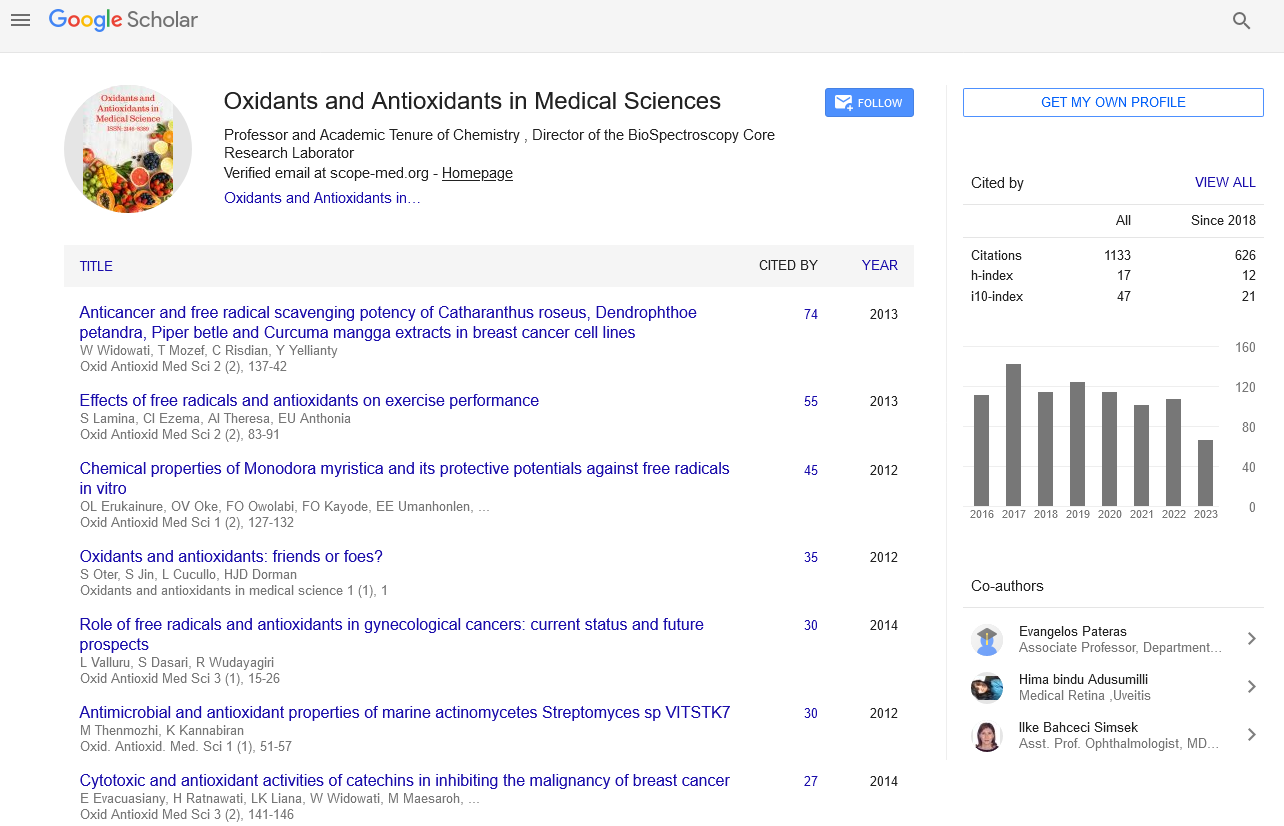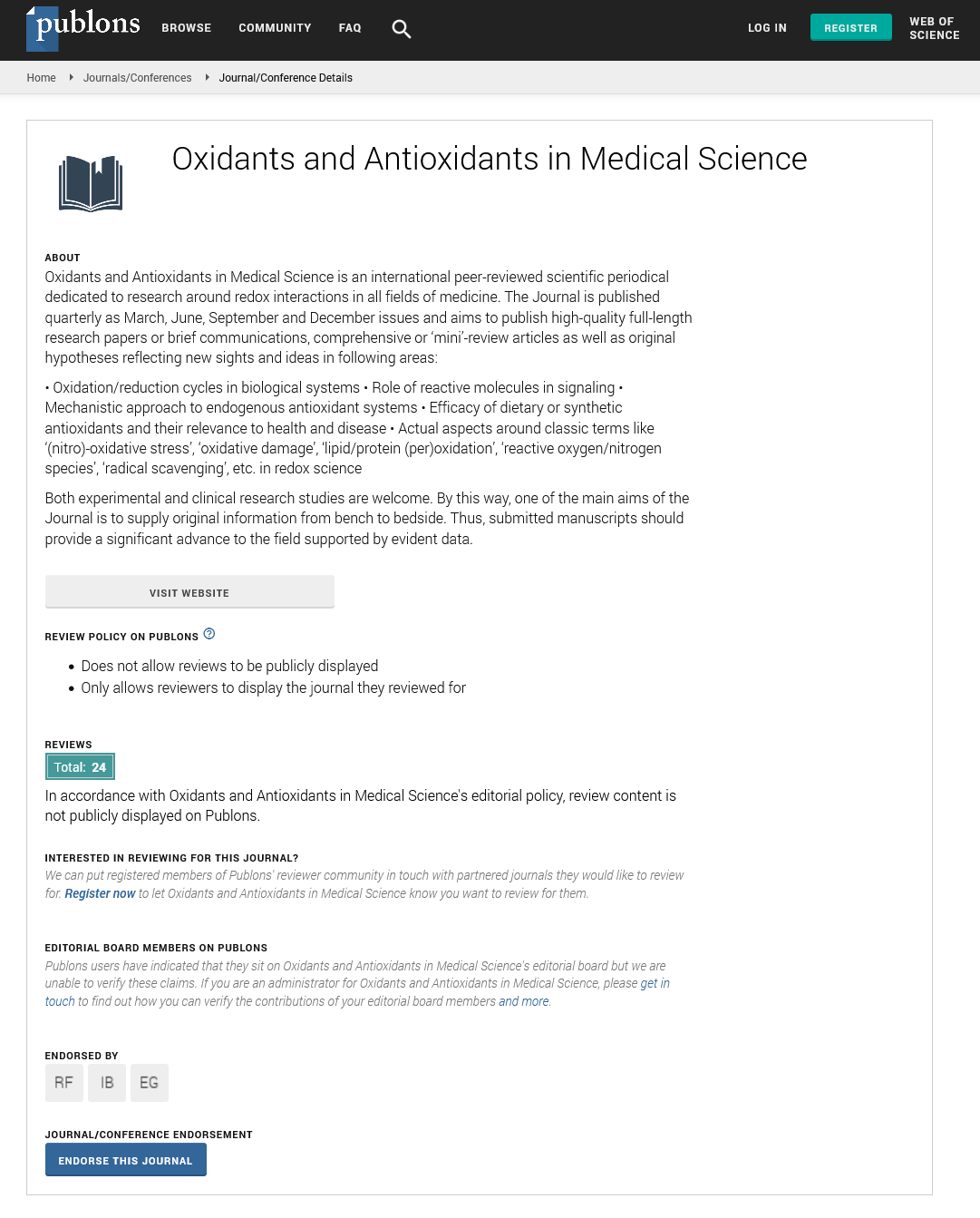Perspective - Oxidants and Antioxidants in Medical Science (2023)
Alpha-Tocopherol: The Antioxidant for Fighting Chronic Diseases
Jeirem Zapa*Jeirem Zapa, Department of Chemistry, University of Auckland, Auckland, New Zealand, Email: jeizapa@gmail.com
Received: 02-Jan-2023, Manuscript No. EJMOAMS -23- 88096; Editor assigned: 05-Jan-2023, Pre QC No. EJMOAMS -23- 88096 (PQ); Reviewed: 20-Jan-2023, QC No. EJMOAMS -23- 88096; Revised: 27-Jan-2023, Manuscript No. EJMOAMS -23- 88096 (R); Published: 03-Feb-2023
Description
Alpha-tocopherol boosts the immune system and helps prevent blood clots. It also helps prevent cell damage caused by free radicals (highly reactive chemicals). Alpha- tocopherol is being studied in the prevention and treatment of certain types of cancer. It is a type of antioxidant. Vitamin E is an important natural antioxidant, and its most abundant and biologically active form is α-tocopherol. In addition, there are specific regulatory effects of vitamin E. The body makes certain efforts to regulate its tissue levels with the help of specific tocopherol transport proteins and membrane receptors. Anti-proliferative effects of alpha-tocopherol and inhibition of protein kinase C that were not mimicked by beta- tocopherol or probucol have been previously demonstrated. Protein kinase C promises to be an important area of interest in the means of the genesis of glaucoma and cataracts. In various models, it has been shown that retinal vascular dysfunction due to hyperglycaemia can be prevented by alpha-tocopherol via the diacylglycerol- protein kinase C pathway. It has been shown that glutamate transporter activity is modulated by protein kinase C. This pathway is also important in reducing the intraocular pressure effects of prostaglandin and its analogues in glaucoma therapy.
In recent years, multiple roles of α-tocopherol have been discovered, which include not only antioxidant functions, but also pro-oxidant functions, cell signaling, and gene regulatory functions. Decades of clinical and preclinical research have expanded our understanding of the antioxidant vitamin E and its utility in a number of chronic conditions caused by oxidative stress. The results of these studies have shown promising, albeit mixed, results about the effectiveness of α-tocopherol in the prevention and treatment of heart disease, cancer and Alzheimer’s disease.
Alzheimer’s disease
In addition to heart disease and cancer, free radical damage is also involved in the aetiology of some neurodegenerative diseases such as Alzheimer’s disease. Alzheimer’s disease is the most common neurodegenerative disease affecting nearly 15 million people worldwide and is present in nearly half of people over the age of 85. Post-mortem brain biopsies in Alzheimer’s disease show accumulation of extracellular senile plaques in neurofibrillary tangles and cerebral blood vessels.
Cancer
The ability of vitamin E, particularly α-tocopherol, to reverse free radical damage, induce apoptosis, and affect oncogene expression makes it a strong candidate for chemotherapeutic strategies. Previous studies have shown that vitamin E inhibits carcinogenesis and DNA damage caused by UV radiation in animal models.
Clinical utility of alpha-tocopherol for cardiovascular diseases
Although there is increasing evidence for the efficacy of α-tocopherol and other antioxidants such as vitamin C in the treatment and/or prevention of cardiovascular disease, there are conflicting reports on the use of vitamin E in clinical trials.
Atherosclerosis
Reactive species in the vasculature are formed mainly due to the activity of NAD (P) H-oxidase, xanthine oxidase, endothelial NO-synthase (eNOS), and the mitochondrial respiratory chain. One of the first events in atherogenesis is the oxidative modification of LDL caused by ROS and/or RNS. Oxidized LDL (oxLDL) stimulates expression of CD36 and Scavenger Receptor-A (SR-A) in monocytes, macrophages, and smooth muscle cells.
Oxidative stress and human diseases
Oxidative stress is a necessary phenomenon in growth, development and differentiation. Processes such as proliferation, wounding, and aging stimulate the generation of lipid hydroperoxides from phospholipids of cell membranes. These reactive lipids can function as signaling molecules and can induce apoptosis.
Copyright: © 2023 The Authors. This is an open access article under the terms of the Creative Commons Attribution Non0-Commercial Share Alike 4.0 (https://creativecommons.org/licenses/by-nc-sa/4.0/). This is an open access article distributed under the terms of the Creative Commons Attribution License, which permits unrestricted use, distribution, and reproduction in any medium, provided the original work is properly cited.







